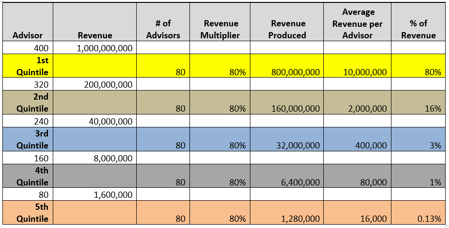In the previous post, I identified 8 clues that would indicate that your sales organization has a sales growth problem (CLICK HERE to read the article and review the 5 clues). In that article, I identified (in some detail) 2 of the 5 constraints to sales growth:
- Weak or lacking performance management
- In-the-moment coaching rather than coaching that changes behavior and improves skill.
I received some feedback that the previous article was tooooo long and so, instead of covering the 3 remaining constraints here, I will present them one at a time (and hope I keep you coming back for “the rest of the story!”).
Constraint #3 - Hiring salespeople based on the wrong criteria with the wrong processes and systems.
 To Hire Better Salespeople, you have to have a better way to attract better salespeople and a better way to eliminate those 90% that will not do 100% of what you need them to do.
To Hire Better Salespeople, you have to have a better way to attract better salespeople and a better way to eliminate those 90% that will not do 100% of what you need them to do.
As in the previous article, let’s first determine “IF” there is a problem (check all that apply):
- You have trouble finding enough candidates to choose from
- The candidates you interview all look and act the same
- When you interview candidates, you…
- Spend time establishing rapport
- Sell them on the company, the position and the opportunity
- Your turnover rate of salespeople that don’t work out is at least a 6-figure problem or 2-comma problem (#,000,000)
- When you evaluate the performance of the current sales team, there are people in the middle of the bell curve that are not performing like you thought they would or expected them to
- You feel desperate to fill seats
- Your recruiting is usually reactive
If you answered honestly and have 3 checks or more, then let’s agree there is a problem.
Several years ago, my son, Anthony, and a good friend of mine, Dave Zimmerman, went with me to NYC to watch the Bengals play the Jets. We were guests of then general manager, Terry Bradway. We met up with Terry the evening before the game just to catch up and introduce him to Anthony. While we were in his hotel room, I asked him what was the most difficult part of his job. Without hesitation, he replied, “Player personnel - that’s the most difficult part of the job.”
He went on to discuss how he and the scouting staff spent Thursdays, Fridays and Saturdays all over the country watching college games. Sometimes they attended two games a day just to find the talent they needed to compete and win on Sundays. Unfortunately, Terry lost his job with the Jets in 2015. Terry is a great guy and a personal friend, but I cannot imagine the pressure and small window for success in drafting NFL players.
In the 2016 NFL draft, there were 256 players drafted. There are roughly 15,588 student athletes playing on college campuses through out the US. Two hundred and fifty six is 1.6% of all the college seniors.
I’m not suggesting that your hit percentage should be the same, but Geoff Smart, author of Who and Topgrading, suggests that it be at least 1 out of 20, or in other terms, 5%.
You may or may not notice the intentional use of the phrase “a better way to ELIMINATE those 90%” in the opening paragraph, but one of the keys to hiring better is to get better at disqualifying candidates!
In our approach to helping companies hire better salespeople, we find that it is critical to first change the mindset of the process and then change the process. The mindset that has to change from “find candidates that qualify” to “disqualifying candidates.” If you work hard at disqualifying, then those that are left are more likely to be successful candidates. Using this approach to hiring - in conjunction with using a predictive sales success assessment - will help you eliminate hiring mistakes!
I won’t go any further into the details about the process of eliminating mistakes here today except to mention one critical component – scorecards. You should have in your possession a scorecard to evaluate talent based on the competencies that are required to succeed. Specifically, that means the competencies, skills and behaviors needed to complete 100% of the job at an extraordinary level. The challenge here, of course, is to sort through the 90% of candidates that are incapable of executing what you need done 100% of the time.
Additional Resource:
Download our free eBook - How to Hire Bankers Who Will Sell






